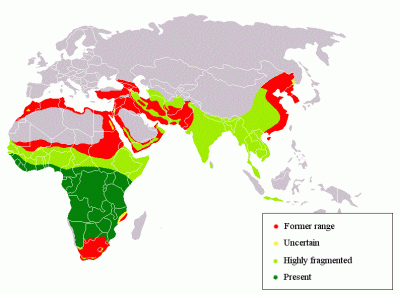Indian Leopard(Panthera Pardus Fusca)
They are a subspecies of leopard. They have strong legs, a long well-formed tail, broad muzzle, short ears and small, yellowish grey eyes, light grey ocular bulbs. Its coat is spotted and rosetted on a pale yellow to yellowish-brown or golden background, except for the melanistic forms; the spots fade toward the white underbelly and the insides and lower parts of the legs. Rosettes are most prominent on the back, flanks and hindquarters. The pattern of the rosettes is unique to each individual.
Juveniles have woolly fur, and appear dark due to the densely arranged spots. The white-tipped tail is 60–100 cm long, white underneath, and displays rosettes, which form incomplete bands toward the end. The rosettes are larger in other leopard subspecies in Asia. Fur colour tends to be more pale and cream in arid habitats, more gray in colder climates, and of a darker golden hue in rainforest habitats.
Habitat
They are found in India, Nepal, Bhutan and parts of Pakistan which is the light green colour on the map in the Asia continent Bangladesh has no leopard population but there are occasional sightings in the forests of Sylhet, Chittagong Hill Tracts and Cox's Bazar. It inhabits tropical rainforests, dry deciduous forests, temperate forests and northern coniferous forests but does not occur in the mangrove forests of the Sundarbans. In Pakistan, it inhabits Himalayan forests and mountainous regions. Leopards are occasionally spotted in the Margalla Hills in winter and are observed preying on monkeys in the woods as well as on local livestock.

Diet
The leopard is elusive, solitary, and largely nocturnal. It is known for its ability in climbing, and has been observed resting on tree branches during the day, dragging its kills up trees and hanging them there, and descending from trees headfirst. It is a powerful swimmer, although is not as disposed to swimming as the tiger. The leopard is a versatile, opportunistic hunter, and has a very broad diet. It is able to take large prey due to its massive skull and powerful jaw muscles. In Sariska Tiger Reserve, the dietary spectrum of the Indian leopard includes axis deer, sambar deer, nilgai, wild boar, common langur, Indian hare and peafowl. In Periyar Tiger Reserve, primates make up a large proportion of its diet.
Breeding
Depending on the region, the leopard mates all year round. The estrous cycle lasts about 46 days and the female usually is in heat for 6–7 days. Gestation lasts for 90-105 days. Cubs are usually born in a litter of 2–4 cubs. Mortality of cubs is estimated at 41–50% during the first year. Females give birth in a cave, crevice among boulders, hollow tree, or thicket to make a den. Cubs are born with closed eyes, which open four to nine days after birth. The fur of the young tends to be longer and thicker than that of adults. Their pelage is also more gray in colour with less defined spots. Around three months of age, the young begin to follow the mother on hunts. At one year of age, leopard young can probably fend for themselves, but remain with the mother for 18–24 months. The average typical life span of a leopard is between 12 and 17 years.
Population
In 2015, 7,910 leopards were estimated to live in and around tiger habitat in India; about 12,000-14,000 leopards were speculated to live in the entire country. The following table gives the major leopard populations in the Indian states. As of 2020, the leopard population within forested habitats in India's tiger range landscapes was estimated at 12,172-13,535 individuals. Surveyed landscapes included elevations below 2,600 m in the Shivalik Hills and Gangetic plains, Central India and Eastern Ghats, Western Ghats, as well as the Brahmaputra River basin and hills in Northeast India
Threats
Hunting of Indian leopards for the illegal wildlife trade is the biggest threat to their survival. They are also threatened by loss of habitat and fragmentation of formerly connected populations, and various levels of human–leopard conflict in human–dominated landscapes. Several newspapers reported of leopards falling into open wells and being rescued with the help of Forest Department officials. A significant immediate threat to wild leopard populations is the illegal trade in poached skins and body parts between India, Nepal and China. The governments of these countries have failed to implement adequate enforcement response, and wildlife crime remained a low priority in terms of political commitment and investment for years. There are well-organised gangs of professional poachers, who move from place to place and set up camp in vulnerable areas. Skins are rough-cured in the field and handed over to dealers, who send them for further treatment to Indian tanning centres. Buyers choose the skins from dealers or tanneries and smuggle them through a complex interlinking network to markets outside India, mainly in China. Seized skins in Kathmandu confirm the city's role as a key staging point for illegal skins smuggled from India bound for Tibet and China.
Conservation
They are currently listed in CITES Appendix I. Despite India and Nepal being contracting parties to CITES, national legislation of both countries does not incorporate and address the spirit and concerns of CITES. Trained human resources, basic facilities and effective networks for control of poaching and trade in wildlife are lacking. Frederick Walter Champion was one of the first in India who after World War I advocated for the conservation of leopards, condemned sport hunting and recognised their key role in the ecosystem. Billy Arjan Singh championed their cause since the early 1970s. There a few leopard rescue centres in India, such as the Manikdoh Leopard Rescue Centre in Junnar, but more rescue and rehabilitation centres are being planned. Some wildlife experts think that such centres are not an ideal solution, but that conflict resolution by way of changing human behaviour, land use or grazing patterns and implementing responsible forest management to lessen human-animal conflict would be far more effective to conserve leopards
